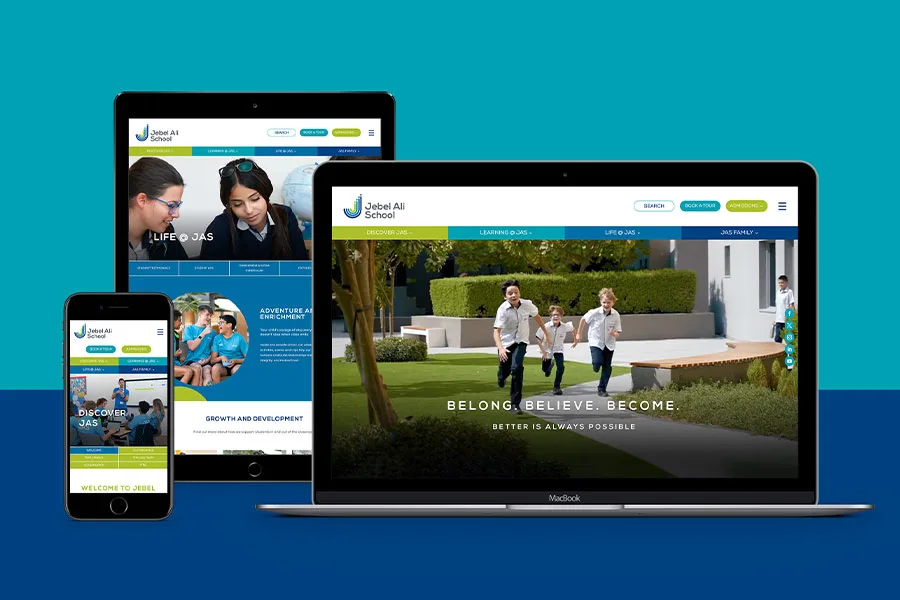In today’s digital world, education is no longer confined to the four walls of a classroom. A school or university’s website has become a vital part of how it connects, communicates, and grows. More than just a source of information, a well-crafted education website is the institution’s digital front door - welcoming prospective students, parents, and educators while showcasing its values, culture, and academic offering.
When done right, it leaves a lasting impression, builds trust, and strengthens credibility. It becomes a key driver of enrolment and long-term engagement.
So, what gives an education website its impact - and why is it such a critical tool for the future of learning?
Key Features of a Good Education Website
1. Clear and Consistent Branding
An education website should have a consistent and recognisable brand identity. From colours and logos to typography and imagery, every design element should reflect the values and mission of the institution. A cohesive visual identity builds trust, establishes authority, and ensures that the website is memorable.
2. User-Friendly Design
The design should be intuitive and accessible, allowing users - whether students, parents, or educators - to navigate seamlessly. Clear call-to-action buttons, easy-to-read fonts, and responsive layouts enhance user experience, making it easier to find important information and engage with content.
3. Mobile Optimisation
With the increasing use of mobile devices for learning, having a mobile-optimised education website is critical. A responsive design ensures that users have a smooth experience across all devices, whether they’re accessing content from a desktop, tablet, or smartphone.
4. Building Emotional Connections
A strong design can evoke emotions that resonate with students, parents and teachers. Whether through a personalised message, or a warm and welcoming tone, design elements should reflect the institution’s mission to inspire and empower students.
The Problem: Common Website Challenges in Education
Managing an education website comes with unique challenges. From keeping content up to date to ensuring a user-friendly experience, many schools and universities face difficulties with outdated platforms that fail to meet their evolving needs. Often, institutions rely on large, industry-specific website providers who don’t fully understand their requirements, leading to frustration and inefficiencies. Some of the most common problems include:
1. Unintuitive Content Management System (CMS)
Many educational institutions rely on CMS platforms that are too complex for non-technical staff, leading to delays in content updates. This inefficiency can result in frustration for marketing teams and missed engagement opportunities.
2. Slow Update Turnaround Times
Often, the more complicated the system, the longer it takes to make changes. Schools may find themselves stuck waiting for updates to be made - sometimes for days or even weeks - impacting their ability to stay current with news, events, and important announcements.
3. Ongoing Costs for Simple Updates
Large CMS platforms often come with additional fees for every update, adding up quickly and straining budgets. This limits the flexibility schools have to make necessary changes without incurring extra costs.
4. Not Tailoring Content
Failing to adjust content and tone of voice for primary school parents and secondary school students can lead to disengagement. Parents require clear, supportive information about their child’s development, while students are more focused on academic progress and future goals. Without tailoring the messaging, both groups may feel disconnected or uninterested, reducing the effectiveness of communication efforts and potentially missing enrolment opportunities.
The Solution: Helping Schools Thrive Online
At Formulate Creative, we’ve helped numerous educational institutions overcome these exact challenges. Recently, we were approached by a leading school in the region to rebuild their website after struggling with a platform that wasn’t meeting their needs. Here’s how we helped:
1. Open-Platform CMS
We redeveloped the website using an open-platform CMS that was easy to manage and update, empowering the school’s marketing team to take control of the content.
2. Optimised User Journey
We optimised the user journey, improving navigation and ensuring key information was easily accessible.
3. Hands-On Training
We provided hands-on training to ensure the team could confidently update the site without relying on external support.
4. Ongoing Support
We offered ongoing support with a personalised, hands-on approach, ensuring the team had the assistance they needed when they needed it.
If your educational institution is dealing with similar issues, don’t let outdated website platforms hold you back. Contact us today to find out how we can help you modernise your website and take control of your digital presence.
